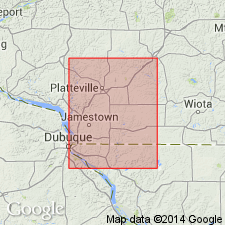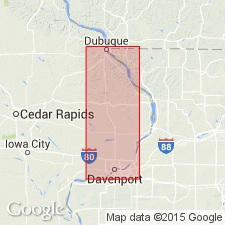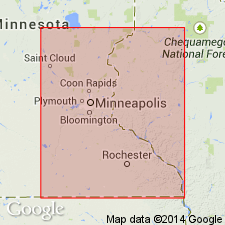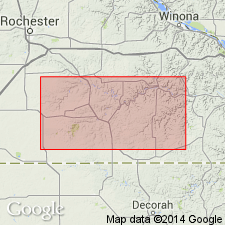
- Usage in publication:
-
- Galena limestone
- Modifications:
-
- Original reference
- Dominant lithology:
-
- Limestone
- AAPG geologic province:
-
- Wisconsin arch
- Iowa shelf
Summary:
Pg. 146-148. Galena limestone. In going westward [from Escanabe River] I had not an opportunity of observing the overlying deposits of Trenton limestone I arrived in Wisconsin. Here, in numerous localities, as well as in Illinois and Iowa, the deposit above that which is marked by an abundance of fossils characteristic of the Trenton, is a grey, or drab-colored limestone, very friable, forming part of "cliff limestone" of Ohio and Indiana reports, and is called by Dr. Owen, in his report on Lead region, the "upper magnesium limestone." From its position and lithological characters it appears that this limestone, which is principal lead-bearing rock in these States, is a continuation of that noticed on the Escanaba, lying above the fossiliferous beds of Trenton limestone; but that it has increased in thickness, as traced westwardly, and becomes an important member of the series; and hence we have designated it in the classification of the rocks as "Galena limestone." In neighborhood of Galena, Dubuque, Mineral Point, and other places there are numerous localities where a direct succession in the beds may be traced. It is very evident that this limestone diminishes in thickness eastwardly from these points, and becomes a very subordinate member of the series, losing at same time, its metalliferous character. This lead-bearing rock, as before observed, rests upon fossiliferous strata of Trenton age. The galena sometimes penetrates the Trenton series, in films or sheets, but does not form veins, as in the gray heavy-bedded limestone above. From all the evidence, therefore, the lead-bearing or Galena limestone must be regarded as a distinct member of lower Silurian system, which is not recognized to the east. Believed to underlie Hudson River group, but relations not positively determined. [In stratigraphic columns on p. 2 and 5, by J.W. Foster and J.D. Whitney, Galena limestone is placed beneath so-called Hudson River group and above Trenton limestone.] Age is Middle Ordovician.
Named from excellent exposures in bluffs of Mississippi River in neighborhood of Galena, Joe Daviess Co., northern IL.
Source: US geologic names lexicon (USGS Bull. 896, p. 790-791).

- Usage in publication:
-
- Galena limestone
- Modifications:
-
- Overview
- AAPG geologic province:
-
- Iowa shelf
- Wisconsin arch
Summary:
Pg. 42, 56, 57, 58, 60. Galena limestone. This rock, which succeeds Trenton limestone proper, or, as shown in preceding sections, alternates with that rock at junction of the two, is a most important and interesting formation in Iowa. It is a gray or drab-colored, often yellowish, porous, and subcrystalline rock, usually friable but sometimes compact and possessing a considerable degree of tenacity. It varies in different parts of its extent; the porous and friable character being that prevailing in central part of its greatest development, while other characters supervene toward its northern and northwestern margin. This rock has been designated by Dr. Owen "Upper Magnesium limestone"; but this term, as originally applied, included also Niagara limestone, causing the two to be confounded for a long time; and in order to avoid the difficulty arising therefrom the name Galena limestone has been proposed. The great interest of this rock arises from its being the chief depository of the lead ore found in Iowa, Illinois, and Wisconsin. [On p. 290, by J.D. Whitney, is statement that city of Galena [Illinois] is surrounded by bluffs of Galena limestone. On p. 350, also by Whitney, is statement that Galena limestone is most fully and characteristically developed on Mississippi River in neighborhood of Galena and Dubuque [Iowa].] Thickness [p. 42, 56, 57, 58] 30 to 250 feet. [The so-called Trenton limestone of Hall is Platteville limestone of modern nomenclature (ca. 1938), and is of Black River age.]
Source: US geologic names lexicon (USGS Bull. 896, p. 790-791).

- Usage in publication:
-
- Galena dolomite*
- Modifications:
-
- Overview
- AAPG geologic province:
-
- Iowa shelf
- Wisconsin arch
Summary:
The Galena dolomite continued for many years to be classified as post-Trenton, although J. Hall in 1862 (Wisconsin Geol. Survey Rpt., no. 1, p. 32-33) assigned it to Trenton group. In 1873 (Minnesota Geol. Nat. Hist. Survey 1st Ann. Rpt.) N.H. Winchell stated that lower beds of Galena are interstratified with underlying Trenton limestone, but he and others continued to treat Galena as post-Trenton. In 1879 (Geol. And Nat. Hist. Survey Minnesota, v. 3, pt. 2, Final Rpt., p. lxxxix) N.H. Winchell and E.O. Ulrich assigned the Galena to the Trenton and the underlying so-called Trenton shales and limestones to the Black River. In 1892 (GSA Bull., v. 3, p. 332-368) C.W. Hail and F.W. Sardeson also definitely assigned the Galena to the Trenton, and divided it and the underlying beds (also called Trenton) into several faunal zones. In 1895 (Amer. Geol., v. 15, p. 33-39) N.H. Winchell stated: "It may therefore be considered that Galena limestone is only a phase of the Trenton intensified in its type region and fading out in all directions." In 1905 H.F. Bain (USGS Bull. 246, p. 18-19) introduced Platteville limestone for the beds underlying the massive-bedded Galena dolomite in northwestern Illinois and southwestern Wisconsin, which he stated are pre-Trenton. In 1906 the upper beds of Platteville limestone of Bain were removed from the Platteville by S. Calvin, who named them Decorah shale and included them in his Platteville stage.
Since 1906 Galena dolomite has been generally accepted as of Trenton age, as overlying Decorah shale, and as underlying Maquoketa shale in Upper Mississippi Valley region. However, A.C. Trowbridge et al., 1935 (Rpt. 9th Ann. Field Conf. Kansas Geol. Soc., fig. 1, p. 61, etc.), use Trenton (Galena) group to include (descending) Dubuque, Stewartville, Prosser, and Decorah exclusive of Spechts Ferry member of Kay, which they include in underlying Platteville limestone. On p. 286 Kay also used this classification, but on p. 288 he stated that in northern Iowa and Minnesota. "It is MORE CONVENIENT [italics [caps] are Kay's] to consider the Spechts Ferry as a lowest member of Decorah formation."
See also under Decorah shale and Platteville limestone.
Source: US geologic names lexicon (USGS Bull. 896, p. 790-791).

- Usage in publication:
-
- Galena formation
- Modifications:
-
- Revised
- AAPG geologic province:
-
- Iowa shelf
Summary:
Pg. 81, 82-90, measured sections. Galena formation. In southern Minnesota, comprises (ascending) Decorah shale, with Guttenberg and Ion submembers, Prosser, and Stewartville members. Overlies Spechts Ferry member of Platteville formation; underlies Dubuque member of Maquoketa formation. Age is Middle Ordovician (Mohawkian).
Source: US geologic names lexicon (USGS Bull. 1200, p. 1453).

- Usage in publication:
-
- Galena group
- Modifications:
-
- Revised
- AAPG geologic province:
-
- Wisconsin arch
Summary:
Pg. 6, fig. 3. Galena group. In Dixon-Oregon area, northern Illinois, comprises (ascending) Spechts Ferry (missing in some places), Guttenberg, Dunleith (new), Wise Lake (new), and Dubuque formations. Overlies Platteville group. Age is Middle Ordovician.
Source: US geologic names lexicon (USGS Bull. 1200, p. 1453).

- Usage in publication:
-
- Galena formation
- Modifications:
-
- Revised
- AAPG geologic province:
-
- Iowa shelf
Summary:
Pg. 763-766. Galena formation. In southeastern Minnesota, comprises carbonate rocks that overlie Decorah shales and underlie limestones and shales of Dubuque formation. Thickness about 93 feet. Includes (ascending) Cummingsville (new), Prosser, and Stewartville members. Age is Middle Ordovician.
Source: US geologic names lexicon (USGS Bull. 1200, p. 1453).

- Usage in publication:
-
- Galena dolomite*
- Modifications:
-
- Revised
- AAPG geologic province:
-
- Wisconsin arch
- Iowa shelf
Summary:
Pg. 255, 257, 259, 261-269, 296-300. Galena dolomite. In lead-zinc district, Galena dolomite is commonly coarsely crystalline massive vuggy dolomite or limestone divisible regionally into two units: a cherty lower unit 105 feet thick and a noncherty upper unit 120 feet thick. Cherty unit is divisible into four zones based primarily upon relative chert content and presence of RECEPTACULITES. Noncherty unit is divided on basis of thinness of bedding and amount of interbedded shale into Dubuque, at top, and the more massive, less shaly Stewartville and zone P of the Prosser below; latter is divided less precisely on basis of RECEPTACULITES which are abundant in the Stewartville but not in zone P below. Name Dubuque is applied much as it has been in past; name Stewartville is applied more or less as it has been in past; name Prosser includes the cherty unit and probably all of zone P overlying noncherty unit. Because of paleontologic deficiencies and because of distinct lithologic difference, the Galena in this report is subdivided into cherty and noncherty units rather than into Prosser, Stewartville, and Dubuque members of common, although not precise, usage. Overlies Decorah formation; underlies Maquoketa shale. Age is Middle Ordovician.
Source: US geologic names lexicon (USGS Bull. 1200, p. 1453).

- Usage in publication:
-
- Galena Formation*
- Galena Group*
- Modifications:
-
- Overview
- AAPG geologic province:
-
- Wisconsin arch
- Illinois basin
- Iowa shelf
Summary:
Used as Galena Formation in Wisconsin and as Galena Group in Illinois and Minnesota [to follow usage of respective State Geological Surveys]. Faunas similar to nautiloid fauna of Lexington Limestone occur in Galena of Wisconsin, Illinois, and Minnesota; Trenton group of New York, Verulam and Lidsay Formations of southern Ontario; and Hull and Sherman Fall Formations in Ottawa region of Ontario and Quebec.
Source: GNU records (USGS DDS-6; Reston GNULEX).
For more information, please contact Nancy Stamm, Geologic Names Committee Secretary.
Asterisk (*) indicates published by U.S. Geological Survey authors.
"No current usage" (†) implies that a name has been abandoned or has fallen into disuse. Former usage and, if known, replacement name given in parentheses ( ).
Slash (/) indicates name conflicts with nomenclatural guidelines (CSN, 1933; ACSN, 1961, 1970; NACSN, 1983, 2005, 2021). May be explained within brackets ([ ]).

